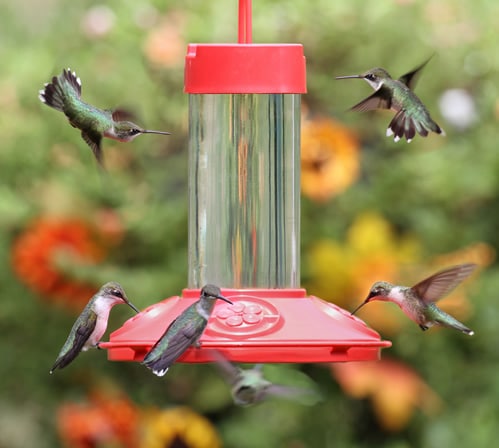Backyard Bird Feeding, Blog - General
Attracting Hummingbirds

The Ruby Throated Hummingbird arrives in the middle latitudes of the United States about the first of May and departs in October. If you live in an extensively wooded area or along a river, you may see them all summer long. Generally we can expect to have them most of May and then returning in mid August until their final departure south. One thing for certain is that a Hummingbird feeder will not stop them from migrating when the time arrives. The key to attracting them is habitat, minimal or no use of pesticides, and the types of flowers in your garden. Hummingbirds can be attracted to feeders containing artificial nectar.
This sweetened water may be purchased commercially or easily made in your kitchen. Clean, fresh nectar is necessary for attracting them to a feeder. The commercial nectar is recommended since the feeder will only need to be rinsed and changed every four to five days. Home made products should be changed every two days. Both are mixed four parts water to one part sugar. When making your own it should be boiled for several minutes, cooled, then stored in the refrigerator until needed. Home made nectar, when left out too long, will ferment forming a bacteria as well as mold that can be harmful. Once you have succeeded in attracting hummingbirds keep the feeder filled. If the nectar runs out they will go off looking for another food source.Nectar provides carbohydrates for energy and has little other nutritional value to it. Hummingbirds are insect eaters, (small spiders, aphids, invertebrate insects) thus using pesticides may eliminate their food supply reducing and reduce the ability to attract them. Note: Adding red food coloring is not recommended.
Attracting Hummingbirds, It’s Fun! It’s Easy!
1. Have your hummingbird feeders out by the first week of May in the spring and on their migration south in early August. You need to be ready before they arrive. It makes attracting them much easier.
2. Hang your feeder in a partially shaded area. Direct sun can cause the sugar and water nectar mixture to separate and leak from your feeder.
3. Hummers are very territorial and some will fight at a feeder. When this happens it is best to set up another feeder in another spot to stop the fighting. Locate a second out of site of the other feeder.
4. A feeder should be cleaned thoroughly once a week in warm water and white vinegar to remove residue. A stiff bottle brush or hand-mop is useful.
5. Do not use any pesticides on flowers from which hummingbirds feed. Hummingbirds get their protein from small invertebrate insects. The nectar only provides a source of energy.
Bananas have Ahh Peel!
To give your hummingbirds an additional treat, you can hang banana skins, which attract fruit flies, a tasty, protein-rich part of their diet.
When Feeding Nectar, Keep it Fresh.
Hummers avoid feeders with spoiled nectar. Commercial nectars last longer, only needing to be changed once a week. Home-made nectar is just fine but needs changing at least every other day as the raw sugar ferments much quicker. Pre-mixed nectars are now available.
Home-made Nectar:
One part sugar to 4 parts boiling water. Always allow the sugar and water solution to come to a rolling boil for a minute or two until sugar is dissolved. Never use a microwave to heat nectar as it alters its chemical structure. Never use artificial sweeteners or add any red coloring. Cool the nectar before filling and refrigerate the rest. And remember to change it every couple of days in hot weather.
Do these things and you’ll soon have a yard “humming” with more Jewels of Spring. Hummingbirds.
More Tips on Attracting Hummingbirds
Published by: The Wild Bird Habitat Stores of Lincoln, Nebraska
